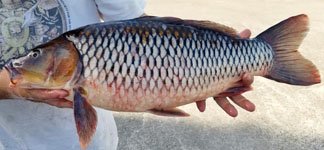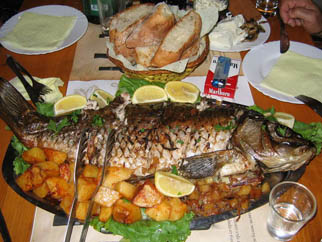Common carp Nutrition facts
Common carp is a freshwater fish inhabiting the warm, shallow waters of the rivers, lakes, ponds, and canals of North America, Europe, Africa, and Asia.
Carp is a member of large Minnow (Cyprinidae) family freshwater fish. Scientific name: Cyprinus carpio. Sub Family: Cyprinidae.
Some of the common names are European carp, German carp, Koi, Katla fish (India), etc.
 |
| Common carp (Cyprinus carpio). Photo credit: U.S. Geological Survey. |
Description
Carp are medium to large-sized fish native to temperate regions of Asia and are one of the many nonnative invasive species found in sluggish or slow-running water bodies of Europe and the Americas.
They are identified by their robust body, large mouth with downturned sucker mouth with two barbels on each side of the upper jaw. The body features a gray or greenish-brown back and yellowish sides, large scales, and somewhat, torpedo-like laterally compressed. The dorsal fin is long and there is a strong spine-like ray. The anal fin is forked.
Common carp can grow to 30 inches long and may weigh as much as 60 pounds, but the average catch size is 3 to 10 lbs (5 kg). Its mild-flavored, white flesh is firm, flaky, and semi-fatty.
Habitat
Common carp is a freshwater fish that prefers to inhabit close to soft mud bottoms where vegetation is found. Adult carp often undertake long-distance migrations during spawning in search of suitable backwaters. They feed on aquatic plants, zooplankton, worms, insect larvae, crustaceans, and mollusks.
Biology
Carp are a fast-growing fish that typically reaches 35 to 45 cm at two to four years of age when they are sexually mature. In their native Indian subcontinent, their spawn coincides with the monsoon rain season, which occurs from April to June.
Life span is about 20 years.
Aquaculture
Carp species (grass carp, silver carp, common carp, and bighead carp) are among the top successfully farmed freshwater fish, accounting for a quarter of global aquaculture production quantity and value.
Common carp alone can be produced in natural food and supplementary feed-based monocultural production systems in shallow, aquatic weed-free drainable ponds, natural lakes, and reservoirs.
Health benefits of Common carp
Common carp is an oily, freshwater fish. It is one of the finest sources of essential fatty acids, protein, minerals, and fat-soluble vitamins like vitamins A, E, and D.
Carp fish is moderately high; 100 g holds 127 calories and 17.8 g/100 g (32% of RDI) of protein. Its white, flaky meat is firm and composes all the essential amino acids in good proportions.
It's lean meat is a good source of polyunsaturated fatty acids (PUFA). Studies suggest a diet rich in fish that are high in omega-3 fatty acids, can curb or prevent cognitive decline, dementia, depression, neuropsychiatric disorders, asthma, and inflammatory disorders.
Carp fish contains just 0.110 ppm of mercury in its flesh. US FDA categorizes Carp fish in the "best choice" section considering mercury levels in its flesh. The recommendation is consumption of 2-3 servings (8-12 ounces) per week for Carp fish.
Carp is a moderate source of omega-3 eicosapentaenoicacid (EPA), docosapantaenoicacid (DPA) and docosahexaenoic acid (DHA) fatty acids. Research studies suggest that these fatty acids, particularly DHA, play an important role in the development of the nervous system, especially in infants and children.
According to Cornell University and the New York Sea Grant Extension Program. 2012- The fatty acids play a crucial role in decreasing blood pressure and heart rate and help improve cardiovascular function. For example, research has shown that omega-3 fatty acids decrease the risk of arrhythmias (abnormal heartbeats) that can lead to sudden death.
100 g of carp holds 988 IU of vitamin D; about 165% of daily recommended intake. Vitamin D plays an important role in the calcium metabolism and offers protection from cancers.
It composes small amounts of vitamin-A (30 IU/100 g) in its flesh; Nonetheless, it carries moderate amounts of omega-3 essential fatty acids such as ALA, DHA, and DPA which help maintain healthy mucosa and skin.
Carp fish compose many B-complex vitamins such as niacin, and pyridoxine (B-6). It is also a good source of vitamin E, vitamin B12 , thiamin, and riboflavin.
Further, it is a natural source of rich minerals including iodine, selenium, phosphorus, calcium, zinc, potassium, and magnesium. Iodine is an important trace element in human nutrition and is essential for thyroid hormone production.
| Principle | Nutrient Value | Percent of RDA |
|---|---|---|
| Energy | 127 Kcal | 6.4% |
| Carbohydrates | 0 g | 0% |
| Protein | 17.8 g | 31.78% |
| Total Fat | 5.6 g | 32% |
| Cholesterol | 66 mg | 22% |
| Dietary Fiber | 0 g | 0% |
| Vitamins | ||
| Folate total | 15 μg | 4% |
| Niacin | 1.64 mg | 10% |
| Pyridoxine | 0.190 mg | 14.5% |
| Riboflavin | 0.055 mg | 4% |
| Thiamin | 0.115 mg | 9.75% |
| Vitamin-A | 30 IU | 1% |
| Vitamin-B12 | 1.53 μg | 63.75% |
| Vitamin-D | 988 IU | 165% | Electrolytes |
| Sodium | 49 mg | 3% |
| Potassium | 333 mg | 7% |
| Minerals | ||
| Calcium | 41 mg | 4% |
| Iron | 1.24 mg | 15.5% |
| Magnesium | 29 mg | 7% |
| Phosphorus | 415 mg | 59% |
| Selenium | 12.6 mg | 23% |
| Zinc | 1.48 mg | 13.5% | Omega-3 fats (PUFA) |
| EPA (20:5 n-3) | 0.238 g | -- |
| DPA (22:5 n-3) | 0.082 g | -- |
| DHA (22:6 n-3) | 0.114 g | -- |
Buying
Carp is usually sold whole, whole gutted, headless, and sometimes fileted with skin on. In the supermarkets, however, one may come across smoked, and canned carp.
Choose fresh whole Carp weighing between 2 and 3 kg. Carp flesh is white, mild in flavor, and has a tender and flaky texture.
Being a semi-fatty fish, carp tend to perish early. To store at home, wrap the fish in heavy-duty freezer bags. Store in the freezer at 0 F or lower.
Fish smoked must be stored in a refrigerator. Use within one month.
Preparation
Carp is a semi-fatty, freshwater fish, and hence, its flavor varies with water and soil qualities. Wild species of carp tend to have a muddy taste. To improve this, the fresh live fish are kept in clean water tubs for a few days. If you buy killed fish from a fishmonger, soak the scaled and gutted carp for 1-2hr in slightly vinegared water, refreshing the water occasionally. To make scaling easier, pour some hot water over the fish and remove the scales with a knife.
Prepare the fish as you would for table use. Cut large fish into steaks or fillets. Discard bones and dark meat as it contains some chemicals.
Here are some serving ideas:
Carp is cooked whole, in filters, or in sections. The cheeks, tongue, and lips are highly sought after. Being a semi-fatty and firm fish, it is suited to all cooking methods. It can be baked, braised, roasted, poached, grilled, or fried.
 |
| Potatoes with Common carp. Photo credit: vesnamarkovska |
Common carp is a popular Christmas Eve dish in many Central and East European regions.
Fisherman's soup (halászlé) is a spicy, bright-red hot Hungarian dish prepared with carp fish and generous amounts of paprika.
It is also prepared delicious carp chowder, stews, and curries.
Popular value-added carp fish products include fish pies, nuggets, fish balls, and patties.
Safety profile
The mean methyl-mercury concentration in common carp is 0.110 ppm. Accordingly, the U.S. FDA's final guidelines on how much fish expectant as well as breastfeeding mothers can eat, along with lists of specific options that are safe or should be avoided, place it in "the best choice" category. By this yardstick, they can consume 2-3 servings (8-12 ounces) of this fish per week. (Medical disclaimer).
Also read ≻≻-
≻≻- Atlantic cod nutrition facts and health benefits.
≻≻- Trout fish nutrition facts and health benefits.
≻≻- Dover sole nutrition facts and health benefits.
≻≻-Back to Seafood from Common carp nutrition facts and health benefits.
Further reading (Links opens in new window):
USGS -Nonindigenous Aquatic Species Cyprinus carpio.
Omega-3 Fatty Acids: An Essential Contribution.